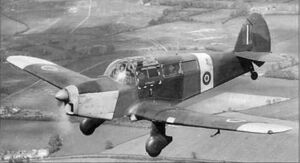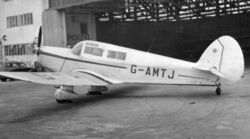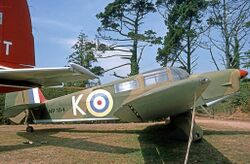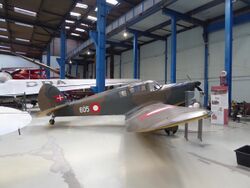Engineering:Percival Proctor
| Proctor | |
|---|---|

| |
| RAF Percival Proctor IV | |
| Role | Radio trainer/communications aircraft |
| Manufacturer | Percival Aircraft Limited |
| Designer | Edgar Percival |
| First flight | 8 October 1939 |
| Retired | 1955 |
| Primary users | Royal Air Force Fleet Air Arm |
| Number built | 1,143 |
| Developed from | Percival Vega Gull |
The Percival Proctor is a British radio trainer and communications aircraft of the Second World War. The Proctor is a single-engined, low-wing monoplane with seating for three or four, depending on the model.
Design and development
The Proctor was developed from the Percival Vega Gull in response to Air Ministry Specification 20/38 for a radio trainer and communications aircraft. To meet the requirement, the aircraft based on the Vega Gull had larger rear cabin windows and the fuselage was six inches (150 mm) longer. Modifications were made to the seats to enable the crew to wear parachutes, and there were other changes to enable a military radio and other equipment to be fitted. In early 1939, an order was placed for 247 aircraft to meet operational requirement OR.65.
The prototype aircraft, serial number P5998, first flew on 8 October 1939 from Luton Airport,[1] and the type was put into production for the RAF and Fleet Air Arm. The prototype was tested as an emergency bomber during 1940 but that idea was abandoned when the invasion threat receded. Although the first 222 aircraft were built by Percival at Luton, most of the remaining aircraft were built by F. Hills & Sons of Trafford Park near Manchester. They built 812 Proctors of several marques between 1941 and 1945, assembling most of the aircraft at Barton Aerodrome.[2]
Whilst the very early Proctors (Mks I to III) followed very closely the last incarnation of the Vega Gull, and consequently retained most of its performance, later versions became much heavier and less aerodynamic, with inevitable detrimental effects upon their performance. The later marques of Proctor, whilst looking broadly similar, were in fact a complete redesign of the aircraft and were much enlarged, heavier and even less efficient. Flight performance was poor. There were later plans to fit them with the 250 horsepower (190 kW) Queen 30 and a larger airscrew, but only one trial aircraft was so fitted, because the all-metal Prentice was being developed to replace the Proctor, utilising the Queen 30 etc.
The Prentice proved to be a very poor aircraft, even worse than the later Proctors, and they served in the RAF for only a handful of years before being withdrawn. After their Service life, the remaining Proctors soldiered on in private hands until the 1960s, when they were all grounded, owing to concerns about the degradation of the glued joints in their wooden airframes. Several surviving Proctors have been rebuilt with modern adhesives and should be returned to the air shortly.[when?] Early Proctors still make good light aircraft, because they combine the Vega's attributes of long range, speed and load-carrying ability. Notably, all Proctors inherited the Vega Gull's feature of wing-folding.[citation needed]
Operational history
The Proctor was initially employed as a three-seat communications aircraft (Proctor I). This was followed by the Proctor II and Proctor III three-seat radio trainers.
In 1941, the Air Ministry issued Specification T.9/41 for a four-seat radio trainer. The P.31 – originally known as the "Preceptor" but finally redesignated the Proctor IV – was developed for this requirement with an enlarged fuselage. One Proctor IV was fitted with a 250 hp (157 kW) Gipsy Queen engine. This was used as a personal transport by AVM Sir Ralph Sorley but production models retained the 210 hp (157 kW) motor of earlier marks.
At the end of the war, many early mark Proctors were sold on the civilian market and were operated in Australia, New Zealand and Europe. The Mk IV continued in service with the RAF until the last was withdrawn in 1955.
In 1945, a civil model derived from the Proctor IV was put into production for private owner, business and light charter use as the Proctor 5. The RAF purchased four to be used by air attachés.
The final model of the line was the solitary Proctor 6 floatplane sold to the Hudson's Bay Company in 1946.
Three highly modified Percival Proctors, nicknamed the "Proctukas," were produced for the film Battle of Britain as stand-ins for the Ju 87 Stuka. After test flights revealed instability, they were ultimately abandoned and never appeared in the film.
Variants
- P.28 Proctor I
- Three-seat dual-control communications and radio/navigation trainer for the Royal Air Force, 147 built.
- P.28 Proctor IA
- Three-seat dual-control deck landing and radio trainer for the Royal Navy/Fleet Air Arm with dinghy stowage and naval instruments, 100 built.
- P.29 Proctor
- One aircraft converted to a light-bomber to carry 16 20 lb (9.1 kg) bombs under the wings for anti-invasion defence.
- P.30 Proctor II
- Three-seat radio trainer, 175 built (including 112 IIA aircraft for the Royal Navy)
- P.31 Proctor IV
- Four-seat radio trainer with enlarged fuselage, 258 built.
- P.34 Proctor III
- Three-seat radio trainer for Bomber Command radio operators, 437 built.
- P.44 Proctor V
- Four-seat civil light aircraft, 150 built. RAF designation was Proctor C.Mk 5
- P.45 Proctor VI
- Floatplane version, 1 built.
- P.46
- Heavily modified Proctor IV fuselage with a new wing, built by Heston Aircraft as the Youngman-Baynes High Lift Monoplane.
- P.47
- Proctor VI variant with 250 hp (190 kW) DH Gipsy Queen 31
Operators
Civil
Civil Proctors have been registered in the following countries; Argentina, Australia, Austria, Belgium, Brazil, Canada, Chile, Denmark, Egypt, Finland, France, Germany, Gold Coast, Iceland, India, Ireland, Italy, Kenya, Lebanon, Morocco, New Zealand, Portugal, Rhodesia, South Africa, Southern Rhodesia, Spain, Sweden, Switzerland, Transjordan, Turkey, United Kingdom and United States.[3]
Military
 Australia
Australia
- Royal Australian Air Force
- Governor-General's Flight RAAF operated one Proctor from 1945 to 1947.
 Belgium
Belgium
- Belgian Air Force
- 367 Squadron received four P.31C delivered in June 1947, one in October and one in March 1948. Operated as liaison aircraft until 1950.[4] Last withdrawn from use 1954.
 Canada
Canada
- Royal Canadian Air Force used Proctors by a number of Canadian units in the RAF as a communications aircraft.
 Czechoslovakia
Czechoslovakia
- Czechoslovakian Air Force in exile in the United Kingdom had one aircraft in service from 1944 to 1945.
 Denmark
Denmark
- Royal Danish Air Force (RDAF) operated six P.44 Mk. III between November 1945 and November 1951. First aircraft operated by RDAF after World War II.
 France
France
- Armée de l'Air received 18 Proctor IVs between September 1945 and May 1946 for use by ERN 703 (Radio Navigation School) in Pau. When the navigation training was transferred to Morocco in 1949 the Proctors were replaced by Ansons and 16 Proctors went to the civil market.
 Italy
Italy
- Italian Air Force bought one former civil Proctor V in 1954.[5]
 Jordan
Jordan
 Lebanon
Lebanon
 Netherlands
Netherlands
- Royal Netherlands Air Force received one Proctor III in June 1946 (scrapped in February 1951) and 10 Proctor IVs in June 1947. Used as liaison aircraft they were all scrapped in October 1953.[6]
 Poland
Poland
- Polish Air Force in Great Britain operated a few aircraft for liaison duties. Example aircraft: DX190, LZ603.
 Syria
Syria
- Syrian Army bought four new Proctor IVs in 1946.
 United Kingdom
United Kingdom
- Royal Air Force
- No. 24 Squadron RAF
- No. 31 Squadron RAF
- No. 117 Squadron RAF
- No. 173 Squadron RAF
- No. 267 Squadron RAF
- No. 510 Squadron RAF
- Middle East Communications Squadron RAF
- No. 2 Radio School RAF
- No. 4 Radio School RAF
- No. 2 Signals School RAF
- No. 4 Signals School RAF
- Fleet Air Arm
- 752 Naval Air Squadron
- 754 Naval Air Squadron
- 755 Naval Air Squadron
- 756 Naval Air Squadron
- 758 Naval Air Squadron
- 771 Naval Air Squadron
 United States
United States
- United States Army Air Forces operated loaned RAF aircraft as communications aircraft for use in the United Kingdom.
Notable Owners
- Nevil Shute flew his newly purchased Proctor V from England to Australia in 1948 and terminated the return flight in Italy, 1500 miles short of his goal, after a ground loop caused by a crosswind landing damaged the undercarriage. Italian bureaucracy delayed the importation of replacement parts and he was forced to return to England by commercial airline. The adventure is described in the book Flight of fancy by his passenger James Riddell.The journey would have been a remarkable achievement even 70 years later using modern radio and navigation aids while in the immediate post war years was a truly daunting challenge.
Surviving aircraft
- Australia
- P6187 / VH-UXS (VH-DUL)– Proctor I airworthy with Paul Alexander Gliddon of Kalamunda, Western Australia. It was restored by Latrobe Valley Airframes and Welding.[7][8]
- P6245 / VH-FEP – Proctor I on static display at the National Museum of Australia in Canberra, Australian Capital Territory.[9][10]
- BV658 / VH- AVG - Proctor II on static display at the Central Australian Aviation Museum in Alice Springs in the Northern Territory,[11]
- Z7203 / VH-BQR– Proctor III on static display at the Aviation Heritage Museum in Perth, Western Australia.[12][13]
- P6194 / VH-AUC – Proctor I on static display at the Australian National Aviation Museum in Melbourne, Victoria.[14]
- Denmark
- 62-605 – Proctor III on static display at the Danish Museum of Science and Technology in Helsingor, Hovedstaden.[15]
- New Zealand
- AE.097 – Proctor V airworthy with the Stan Smith Collection in Dairy Flat, Auckland.[16]
- AE.143 – Proctor V airworthy with the New Zealand Sport and Vintage Aviation Society in Masterton, Wellington.[17]
- P6271 – Proctor I airworthy with the Croydon Aircraft Company in Mandeville, Southland. It is configured as a Vega Gull.[18]
- United Kingdom
- AE.058 – Proctor V under restoration to airworthy at Great Oakley Airfield in Great Oakley, Essex.[19][20]
- AE.129 – Proctor IV airworthy at the Cornwall Aviation Heritage Centre in St Mawgan, Cornwall.[21][22] Originally used as a corporate communications aircraft by Rolls-Royce, it was previously owned by Air Atlantique and operated as part of the Classic Air Force .[23]
- BV651 – Proctor III in storage at London Biggin Hill Airport in London.[24][25]
- HM534 – Proctor III under restoration to airworthy at Great Oakley Airfield in Great Oakley, Essex.[19]
- LZ766 – Proctor III on static display at the Imperial War Museum Duxford in Duxford, Cambridgeshire. It was built by Hills.[26][27]
- LZ791 – Proctor III under restoration to airworthy at Great Oakley Airfield in Great Oakley, Essex.[19]
- NP294 – Proctor IV under restoration to static display at the Lincolnshire Aviation Heritage Centre in East Kirkby, Lincolnshire.[28][29]
- RM169 – Proctor IV under restoration to airworthy at Great Oakley Airfield in Great Oakley, Essex.[19]
- RM221 – Proctor IV airworthy at London Biggin Hill Airport in London.[30]
- Z7197 – Proctor III in storage at the Reserve Collection of the Royal Air Force Museum in Stafford, Staffordshire.[31]
- Z7252 – Proctor III stored at London Biggin Hill Airport in London. It was damaged in a landing accident in July 2012.[32][33]
Specifications (Proctor IV)
Data from The Hamlyn Concise Guide to British Aircraft of World War II,[34] British civil aircraft 1919-1972 Volume III[35]
General characteristics
- Crew: 1 / 2
- Capacity: 2 / 1
- Length: 28 ft 2 in (8.59 m)
- Wingspan: 39 ft 6 in (12.04 m)
- Height: 7 ft 3 in (2.21 m)
- Wing area: 202 sq ft (18.8 m2)
- Airfoil: RAF 48 modified[36]
- Empty weight: 2,340 lb (1,061 kg)
- Gross weight: 3,500 lb (1,588 kg)
- Powerplant: 1 × de Havilland Gipsy Queen II 6-cylinder air-cooled inverted in-line piston engine, 210 hp (160 kW)
- Propellers: 2-bladed variable-pitch propeller
Performance
- Maximum speed: 157 mph (253 km/h, 136 kn)
- Cruise speed: 135 mph (217 km/h, 117 kn)
- Stall speed: 48 mph (77 km/h, 42 kn) [37]
- Range: 500 mi (800 km, 430 nmi)
- Service ceiling: 14,000 ft (4,300 m)
- Rate of climb: 700 ft/min (3.6 m/s)
Notable appearances in media
The Proctor was mentioned in the song "Flying Doctor" by Hawklords (1978)
It was Biggles' main aircraft in the Air Police stories by W.E. Johns
Two Proctors were modified with angular gull wings to resemble Junkers Ju 87 Stukas for the 1969 film Battle of Britain, and were dubbed Proctukas.
See also
Related development
Aircraft of comparable role, configuration and era
- Harlow PJC-2
- Messerschmitt Bf 108
- Miles Mercury
- Miles Messenger
Related lists
- List of aircraft of World War II
- List of aircraft of the RAF
- List of aircraft of the Fleet Air Arm
References
Notes
- ↑ Thetford, Owen. Aircraft of the Royal Air Force 1918–57, 1st edition. London: Putnam, 1957.
- ↑ Scholefield 2004, p. 227.
- ↑ Gearing 2012, pp. 193–259.
- ↑ Jackson 1977, p. 75.
- ↑ "Italian Air Force". aeroflight. http://www.aeroflight.co.uk/waf/italy/af/ital-af2-all-time.htm.
- ↑ Jackson 1978, p. 96.
- ↑ "Aircraft register search [VH-UXS"]. Australian Government. http://www.casa.gov.au/aircraft-register?vh=UXS.
- ↑ "Airframe Dossier - Percival Proctor I, s/n P6187 RAF, c/n K.246, c/r VH-UXS". http://www.aerialvisuals.ca/AirframeDossier.php?Serial=17244.
- ↑ "Percival Proctor Mk 1 monoplane VH-FEP". http://trove.nla.gov.au/work/234398026.
- ↑ "Airframe Dossier - Percival-Hillson Proctor I, s/n P6245 RAF, c/n K.279, c/r VH-FEP". http://www.aerialvisuals.ca/AirframeDossier.php?Serial=172210.
- ↑ "Percival Proctor". https://centralaustralianaviationmuseum.org.au/exhibit/percival-proctor.
- ↑ "Percival Proctor". http://www.raafawa.org.au/museum/aircraft/proctor/index.html.
- ↑ "Airframe Dossier - Percival Proctor III, s/n Z7203 RAF, c/n K.392, c/r VH-BQR". http://www.aerialvisuals.ca/AirframeDossier.php?Serial=119383.
- ↑ "Percival Proctor 1 VH-AUC". http://www.aarg.com.au/percival-proctor.html.
- ↑ "Airframe Dossier - Percival Proctor III, s/n 62-605 RDAF, c/n H.274, c/r OY-ACP". http://www.aerialvisuals.ca/AirframeDossier.php?Serial=77458.
- ↑ "Airframe Dossier - Percival Proctor V, c/n AE.097, c/r ZK-ARP". http://www.aerialvisuals.ca/AirframeDossier.php?Serial=6294.
- ↑ "Airframe Dossier - Percival Proctor V, c/n AE.143, c/r ZK-AQZ". http://www.aerialvisuals.ca/AirframeDossier.php?Serial=7955.
- ↑ "Airframe Dossier - Percival Proctor I, s/n P6271 RAF, c/n K.305, c/r ZK-DPP". http://www.aerialvisuals.ca/AirframeDossier.php?Serial=17818.
- ↑ 19.0 19.1 19.2 19.3 "Restorations". http://www.greatoakleyairfield.co.uk/Pages/restorations.html.
- ↑ "Airframe Dossier - Percival Proctor 5, c/n AE.058, c/r G-AHTE". http://www.aerialvisuals.ca/AirframeDossier.php?Serial=120658.
- ↑ "1948 PERCIVAL PROCTOR 5 MONOPLANE". 12 Sep 2015. http://www.bonhams.com/auctions/22725/lot/388.
- ↑ "Airframe Dossier - Percival Proctor 5, c/n AE.129, c/r G-AKIU". http://www.aerialvisuals.ca/AirframeDossier.php?Serial=63138.
- ↑ "BORN OF THE WINGS OF A GULL". http://www.classicairforce.com/proctor-info.
- ↑ "Airframe Dossier - Percival Proctor III, s/n BV651 RAF, c/r G-AOGE". http://www.aerialvisuals.ca/AirframeDossier.php?Serial=122027.
- ↑ "Percival Proctor". http://www.demobbed.org.uk/aircraft.php?type=870.
- ↑ "Airframe Dossier - Percival Proctor III, s/n LZ766 RAF, c/n H.536, c/r G-ALCK". http://www.aerialvisuals.ca/AirframeDossier.php?Serial=57634.
- ↑ "PERCIVAL PROCTOR III". http://www.iwm.org.uk/collections/item/object/70000210.
- ↑ "Aircraft". http://www.lincsaviation.co.uk/museum/aircraft.htm.
- ↑ "Airframe Dossier - Percival Proctor IV, s/n NP294 RAF, c/n H.678". http://www.aerialvisuals.ca/AirframeDossier.php?Serial=98078.
- ↑ "Airframe Dossier - Percival Proctor IV, s/n RM221 RAF, c/r G-ANXR". http://www.aerialvisuals.ca/AirframeDossier.php?Serial=136378.
- ↑ "Airframe Dossier - Percival Proctor III, s/n Z7197 RAF, c/n K.386, c/r G-AKZN". http://www.aerialvisuals.ca/AirframeDossier.php?Serial=108913.
- ↑ "Airframe Dossier - Percival Proctor IV, s/n Z7252 RAF, c/r G-ALJF". http://www.aerialvisuals.ca/AirframeDossier.php?Serial=119537.
- ↑ "ASN Wikibase Occurrence # 147416". http://aviation-safety.net/wikibase/147416.
- ↑ Mondey, David. The Hamlyn Concise Guide to British Aircraft of World War II. London: Chancellor Press, 1994. ISBN:1-85152-668-4.
- ↑ Jackson, A. J. (1974). British civil aircraft 1919-1972 Volume III (2nd ed.). London: Putnam. pp. 107–111, 516–526. ISBN 978-0-370-10014-2.
- ↑ Lednicer, David. "The Incomplete Guide to Airfoil Usage". https://m-selig.ae.illinois.edu/ads/aircraft.html.
- ↑ Air Transport Auxiliary Ferry Pilots Notes (reproduction ed.). Elvington, York, UK: Yorkshire Air Museum. 1996. ISBN 0-9512379-8-5.
Bibliography
- Ellison, Norman H. Percivals Aircraft (The Archive Photographs Series). Chalford, Stroud, UK: Chalford Publishing Company, 1997. ISBN:0-7524-0774-0.
- Gearing, David. W. On the Wings of a Gull - Percival and Hunting Aircraft. Stapleford, UK:Air-Britain (Historians), 2012. ISBN:978-0-85130-448-9.
- Jackson Paul A. Belgian Military Aviation 1945-1977. London: Midland Counties Publications, 1977. ISBN:0-904597-06-7.
- Jackson Paul A. Dutch Military Aviation 1945-1978. London: Midland Counties Publications, 1978. ISBN:0-904597-11-3.
- Percival, Robert. "A Portrait of Percival." Aeroplane Monthly, Vol. 12, No. 9, September 1984.
- Scholefield, R.A. "Manchester's Early Airfields", an extended chapter in Moving Manchester. Stockport, Cheshire, UK: Lancashire & Cheshire Antiquarian Society, 2004. ISSN 0950-4699.
- Silvester, John. "Percival Aircraft 1933–1954 (Parts 1–4)." Aeroplane Monthly, Vol. 11, No. 1-4, January–April 1983.
External links
 |




